Toyota's Operations, Logistics, and Supply Chain Analysis
VerifiedAdded on 2021/02/18
|11
|2861
|100
Report
AI Summary
This report provides a critical review of Toyota's operations, logistics, and supply chain management, focusing on new product development and quality management within the automobile industry. It explores the application of the House of Quality model and Total Quality Management (TQM) to enhance customer satisfaction and brand loyalty. The report examines key aspects such as product design, supply chain efficiency, and the impact of economic, environmental, and social factors on Toyota's business. It highlights the importance of effective communication, continuous improvement, and a customer-centric approach for achieving operational excellence. The analysis includes recommendations for improving quality delivery and customer satisfaction through periodic service delivery and strategic considerations. The report emphasizes the need for Toyota to adapt to market dynamics and maintain a strong brand image through customer-focused initiatives.
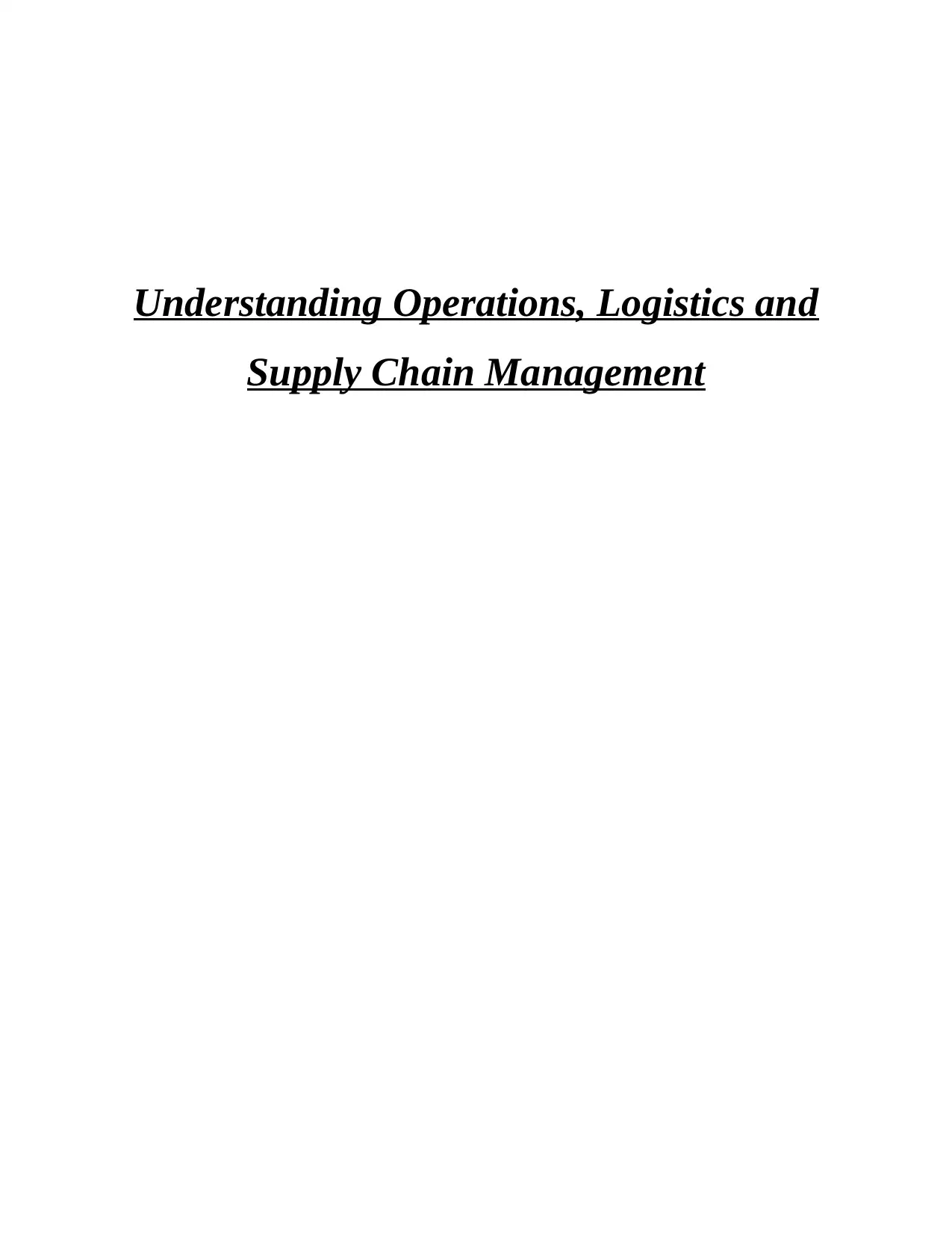
Understanding Operations, Logistics and
Supply Chain Management
Supply Chain Management
Paraphrase This Document
Need a fresh take? Get an instant paraphrase of this document with our AI Paraphraser
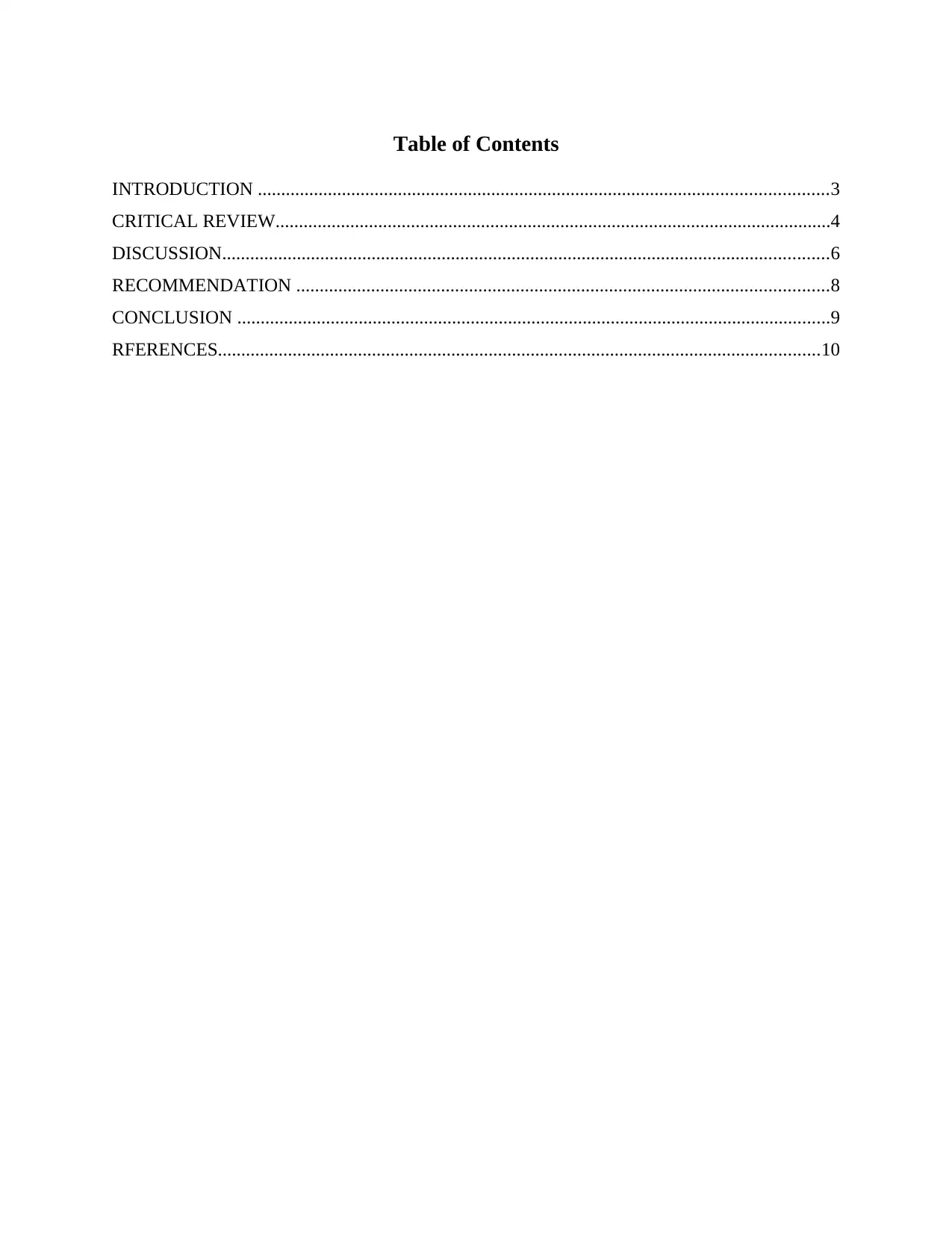
Table of Contents
INTRODUCTION ..........................................................................................................................3
CRITICAL REVIEW.......................................................................................................................4
DISCUSSION..................................................................................................................................6
RECOMMENDATION ..................................................................................................................8
CONCLUSION ...............................................................................................................................9
RFERENCES.................................................................................................................................10
INTRODUCTION ..........................................................................................................................3
CRITICAL REVIEW.......................................................................................................................4
DISCUSSION..................................................................................................................................6
RECOMMENDATION ..................................................................................................................8
CONCLUSION ...............................................................................................................................9
RFERENCES.................................................................................................................................10
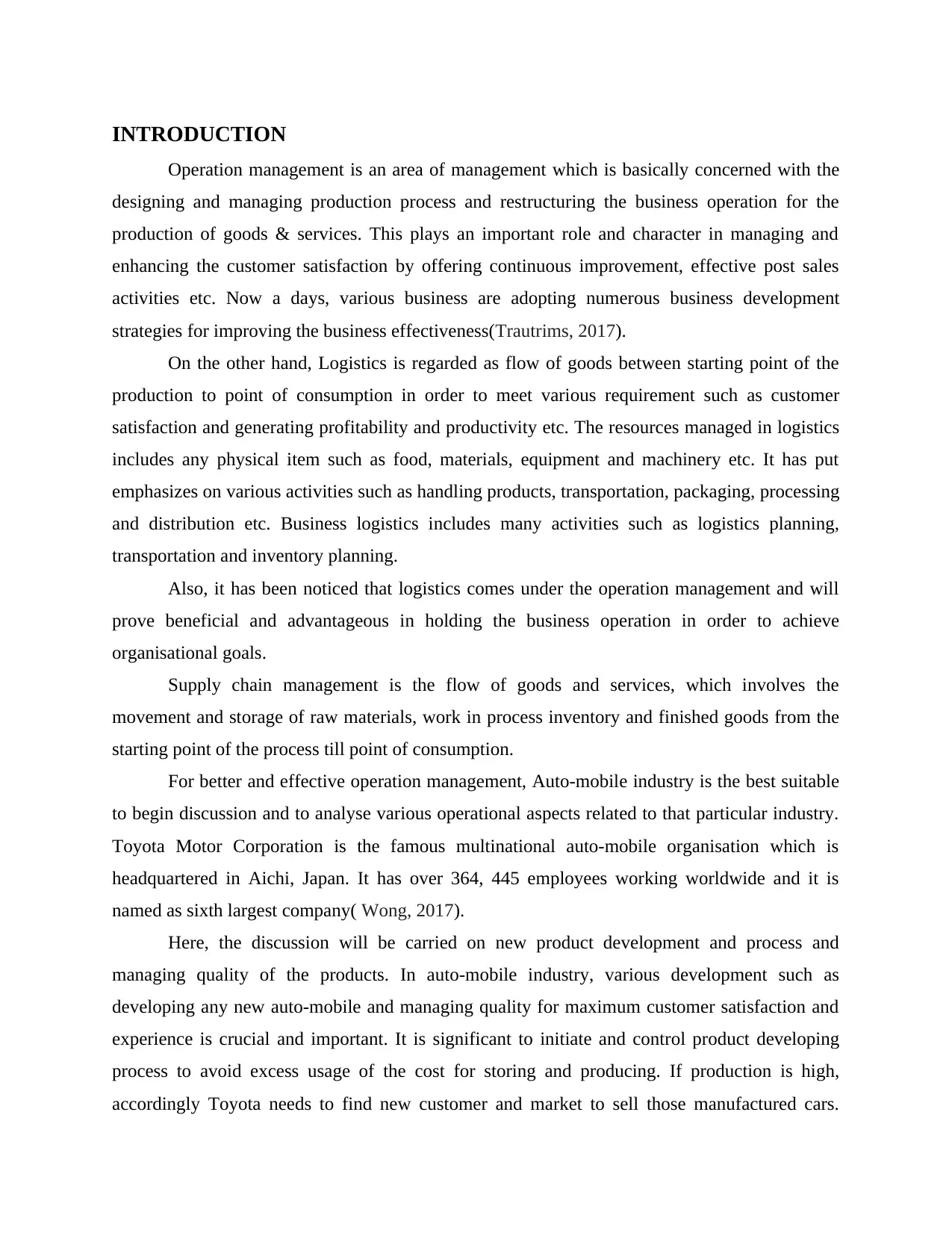
INTRODUCTION
Operation management is an area of management which is basically concerned with the
designing and managing production process and restructuring the business operation for the
production of goods & services. This plays an important role and character in managing and
enhancing the customer satisfaction by offering continuous improvement, effective post sales
activities etc. Now a days, various business are adopting numerous business development
strategies for improving the business effectiveness(Trautrims, 2017).
On the other hand, Logistics is regarded as flow of goods between starting point of the
production to point of consumption in order to meet various requirement such as customer
satisfaction and generating profitability and productivity etc. The resources managed in logistics
includes any physical item such as food, materials, equipment and machinery etc. It has put
emphasizes on various activities such as handling products, transportation, packaging, processing
and distribution etc. Business logistics includes many activities such as logistics planning,
transportation and inventory planning.
Also, it has been noticed that logistics comes under the operation management and will
prove beneficial and advantageous in holding the business operation in order to achieve
organisational goals.
Supply chain management is the flow of goods and services, which involves the
movement and storage of raw materials, work in process inventory and finished goods from the
starting point of the process till point of consumption.
For better and effective operation management, Auto-mobile industry is the best suitable
to begin discussion and to analyse various operational aspects related to that particular industry.
Toyota Motor Corporation is the famous multinational auto-mobile organisation which is
headquartered in Aichi, Japan. It has over 364, 445 employees working worldwide and it is
named as sixth largest company( Wong, 2017).
Here, the discussion will be carried on new product development and process and
managing quality of the products. In auto-mobile industry, various development such as
developing any new auto-mobile and managing quality for maximum customer satisfaction and
experience is crucial and important. It is significant to initiate and control product developing
process to avoid excess usage of the cost for storing and producing. If production is high,
accordingly Toyota needs to find new customer and market to sell those manufactured cars.
Operation management is an area of management which is basically concerned with the
designing and managing production process and restructuring the business operation for the
production of goods & services. This plays an important role and character in managing and
enhancing the customer satisfaction by offering continuous improvement, effective post sales
activities etc. Now a days, various business are adopting numerous business development
strategies for improving the business effectiveness(Trautrims, 2017).
On the other hand, Logistics is regarded as flow of goods between starting point of the
production to point of consumption in order to meet various requirement such as customer
satisfaction and generating profitability and productivity etc. The resources managed in logistics
includes any physical item such as food, materials, equipment and machinery etc. It has put
emphasizes on various activities such as handling products, transportation, packaging, processing
and distribution etc. Business logistics includes many activities such as logistics planning,
transportation and inventory planning.
Also, it has been noticed that logistics comes under the operation management and will
prove beneficial and advantageous in holding the business operation in order to achieve
organisational goals.
Supply chain management is the flow of goods and services, which involves the
movement and storage of raw materials, work in process inventory and finished goods from the
starting point of the process till point of consumption.
For better and effective operation management, Auto-mobile industry is the best suitable
to begin discussion and to analyse various operational aspects related to that particular industry.
Toyota Motor Corporation is the famous multinational auto-mobile organisation which is
headquartered in Aichi, Japan. It has over 364, 445 employees working worldwide and it is
named as sixth largest company( Wong, 2017).
Here, the discussion will be carried on new product development and process and
managing quality of the products. In auto-mobile industry, various development such as
developing any new auto-mobile and managing quality for maximum customer satisfaction and
experience is crucial and important. It is significant to initiate and control product developing
process to avoid excess usage of the cost for storing and producing. If production is high,
accordingly Toyota needs to find new customer and market to sell those manufactured cars.
⊘ This is a preview!⊘
Do you want full access?
Subscribe today to unlock all pages.

Trusted by 1+ million students worldwide

Same with managing quality, organisation needs to implement various strategies ans plans to
enhance the quality level of Toyota's products and services. For effective quality, organisation is
required to revise and restructure their strategies and policies to risen the customer satisfaction
by proper delivery system, logistics management and time to time services to their car and auto-
mobile. New products developing is the most critical and complicated stage, where an auto-
mobile company needs to design the concept and idea of the products, along with the final
screening and brief market research to arrive at one common result. This report will cover each
and every aspects of the new product development and managing quality etc.
CRITICAL REVIEW
In context with Toyota, house of quality is the customer's voice for the analysis tool and
also the key components of functional deployment technique. Generally, this model starts with
voice of the customer which is need to be analysed and translate that what customer wants into
the specific products or services. This process involves engineering design values and technique
by creating the relationship matrix(Grant, 2016). Quality function deployment consists of the
function such as House of quality are used to identifying and managing the design trade-off. For
creating Effective HOQ, it is necessary to follow certain procedure and steps involved in
understanding the customer requirements and its conversion into final outcome of the products.
In context with Toyota motors, this is the best suitable theory and models to analyse operation,
logistics and supply chain management for enhance the production capacity and ensure new
product development and process:
In Auto-mobile, customer buys benefits and producers offers features on the price
satisfaction. When design particular car, organisation needs to decide and analyse the actual
customer requirements. As this is a hypothetical scenario, it requires brief research and study to
ascertain and find all relevant data and information. Hence, six requirements has been noticed in
the car such as speed, safety, low fuel consumption, cheap and reliable. Toyota needs to maintain
such basic requirements in their priorities to offer the customer.
Before new product development and design by Toyota, it is required to identify and
analyse specific characteristics available in the product, premium features or attributes and how
all these will satisfy customer needs and wants. In context with Toyota, if auto-mobile is looking
for premium car, they needs to analyse what will be the price of the car and how customer will
get satisfy in that price level.
enhance the quality level of Toyota's products and services. For effective quality, organisation is
required to revise and restructure their strategies and policies to risen the customer satisfaction
by proper delivery system, logistics management and time to time services to their car and auto-
mobile. New products developing is the most critical and complicated stage, where an auto-
mobile company needs to design the concept and idea of the products, along with the final
screening and brief market research to arrive at one common result. This report will cover each
and every aspects of the new product development and managing quality etc.
CRITICAL REVIEW
In context with Toyota, house of quality is the customer's voice for the analysis tool and
also the key components of functional deployment technique. Generally, this model starts with
voice of the customer which is need to be analysed and translate that what customer wants into
the specific products or services. This process involves engineering design values and technique
by creating the relationship matrix(Grant, 2016). Quality function deployment consists of the
function such as House of quality are used to identifying and managing the design trade-off. For
creating Effective HOQ, it is necessary to follow certain procedure and steps involved in
understanding the customer requirements and its conversion into final outcome of the products.
In context with Toyota motors, this is the best suitable theory and models to analyse operation,
logistics and supply chain management for enhance the production capacity and ensure new
product development and process:
In Auto-mobile, customer buys benefits and producers offers features on the price
satisfaction. When design particular car, organisation needs to decide and analyse the actual
customer requirements. As this is a hypothetical scenario, it requires brief research and study to
ascertain and find all relevant data and information. Hence, six requirements has been noticed in
the car such as speed, safety, low fuel consumption, cheap and reliable. Toyota needs to maintain
such basic requirements in their priorities to offer the customer.
Before new product development and design by Toyota, it is required to identify and
analyse specific characteristics available in the product, premium features or attributes and how
all these will satisfy customer needs and wants. In context with Toyota, if auto-mobile is looking
for premium car, they needs to analyse what will be the price of the car and how customer will
get satisfy in that price level.
Paraphrase This Document
Need a fresh take? Get an instant paraphrase of this document with our AI Paraphraser

Requirements Expected
This brief table will tells about the basic and
other requirements from the customer before
conducting product design and process.
Requirements can be technical, safety, price
factor etc. What customer is looking from
particular auto-mobile products mainly safety
factors, low fuel consumption, cheap and
reliability.
This show what sort of requirements or wants
can be fulfilled to auto-mobile product of
Toyota motors. All such needs and wants can
be fulfilled on the basis of set budget for
production of car and other vehicle. That
budget will lead to pre-deciding the price of the
car. Toyota needs to take care of the statutory
regulation and standards.
In This step, House of quality requires relationship matrix between various How's. The
main function of identifying such relationship is to establish customer products requirement's
with the performance design to improve the quality and product. In context with Toyota,
company needs to analyse the voice of the customer and link it with increased performance to
provide final and effective products development and design(Davarzani, 2015).
This brief step of building house of quality is little difficult and will take longer period of
time to complete. To take this point, relationship matrix is required between customer
satisfaction and industry current potential. In context with Toyota motors, such rating will show
importance of different variables and specification of particular car product to the customers.
In this step of house of quality, features of Toyota car will be compared to other brands
such as Ford and Hyundai which are renowned brands for both cars and SUV's. To understand
this, two auto-mobile companies has been taken namely Hyundai and Ford. In this matrix,
particular rating will be given to existing features of the Toyota products and compare them with
Ford and Hyundai by giving good, fair and poor in each and every variable.
Desirable technical attributes is the last step of whole house of quality process. The main
purpose is to determine and compare technical attributes and checking the performance of the
Toyota products with respect to the market and competitors such as Ford and Hyundai products.
This brief table will tells about the basic and
other requirements from the customer before
conducting product design and process.
Requirements can be technical, safety, price
factor etc. What customer is looking from
particular auto-mobile products mainly safety
factors, low fuel consumption, cheap and
reliability.
This show what sort of requirements or wants
can be fulfilled to auto-mobile product of
Toyota motors. All such needs and wants can
be fulfilled on the basis of set budget for
production of car and other vehicle. That
budget will lead to pre-deciding the price of the
car. Toyota needs to take care of the statutory
regulation and standards.
In This step, House of quality requires relationship matrix between various How's. The
main function of identifying such relationship is to establish customer products requirement's
with the performance design to improve the quality and product. In context with Toyota,
company needs to analyse the voice of the customer and link it with increased performance to
provide final and effective products development and design(Davarzani, 2015).
This brief step of building house of quality is little difficult and will take longer period of
time to complete. To take this point, relationship matrix is required between customer
satisfaction and industry current potential. In context with Toyota motors, such rating will show
importance of different variables and specification of particular car product to the customers.
In this step of house of quality, features of Toyota car will be compared to other brands
such as Ford and Hyundai which are renowned brands for both cars and SUV's. To understand
this, two auto-mobile companies has been taken namely Hyundai and Ford. In this matrix,
particular rating will be given to existing features of the Toyota products and compare them with
Ford and Hyundai by giving good, fair and poor in each and every variable.
Desirable technical attributes is the last step of whole house of quality process. The main
purpose is to determine and compare technical attributes and checking the performance of the
Toyota products with respect to the market and competitors such as Ford and Hyundai products.
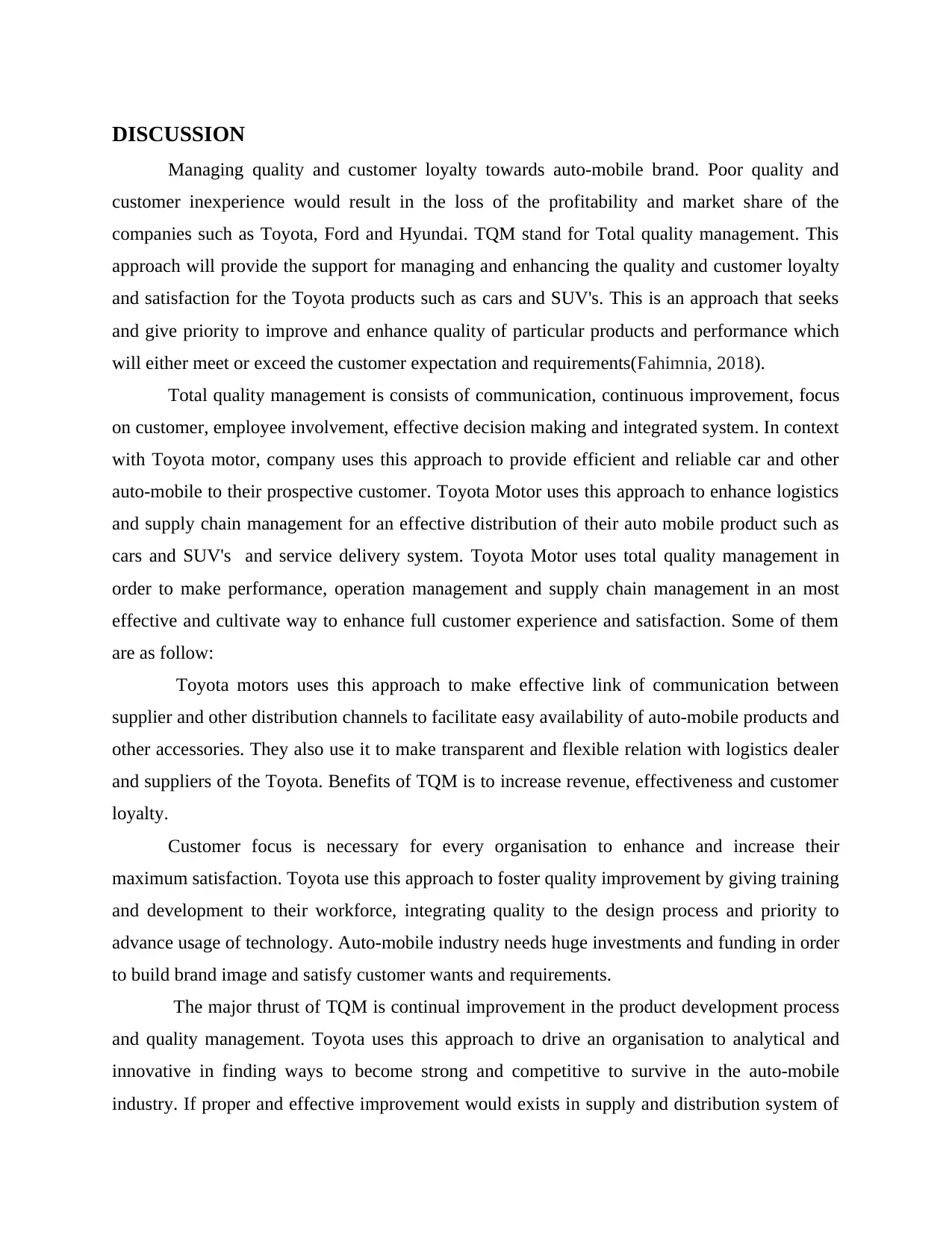
DISCUSSION
Managing quality and customer loyalty towards auto-mobile brand. Poor quality and
customer inexperience would result in the loss of the profitability and market share of the
companies such as Toyota, Ford and Hyundai. TQM stand for Total quality management. This
approach will provide the support for managing and enhancing the quality and customer loyalty
and satisfaction for the Toyota products such as cars and SUV's. This is an approach that seeks
and give priority to improve and enhance quality of particular products and performance which
will either meet or exceed the customer expectation and requirements(Fahimnia, 2018).
Total quality management is consists of communication, continuous improvement, focus
on customer, employee involvement, effective decision making and integrated system. In context
with Toyota motor, company uses this approach to provide efficient and reliable car and other
auto-mobile to their prospective customer. Toyota Motor uses this approach to enhance logistics
and supply chain management for an effective distribution of their auto mobile product such as
cars and SUV's and service delivery system. Toyota Motor uses total quality management in
order to make performance, operation management and supply chain management in an most
effective and cultivate way to enhance full customer experience and satisfaction. Some of them
are as follow:
Toyota motors uses this approach to make effective link of communication between
supplier and other distribution channels to facilitate easy availability of auto-mobile products and
other accessories. They also use it to make transparent and flexible relation with logistics dealer
and suppliers of the Toyota. Benefits of TQM is to increase revenue, effectiveness and customer
loyalty.
Customer focus is necessary for every organisation to enhance and increase their
maximum satisfaction. Toyota use this approach to foster quality improvement by giving training
and development to their workforce, integrating quality to the design process and priority to
advance usage of technology. Auto-mobile industry needs huge investments and funding in order
to build brand image and satisfy customer wants and requirements.
The major thrust of TQM is continual improvement in the product development process
and quality management. Toyota uses this approach to drive an organisation to analytical and
innovative in finding ways to become strong and competitive to survive in the auto-mobile
industry. If proper and effective improvement would exists in supply and distribution system of
Managing quality and customer loyalty towards auto-mobile brand. Poor quality and
customer inexperience would result in the loss of the profitability and market share of the
companies such as Toyota, Ford and Hyundai. TQM stand for Total quality management. This
approach will provide the support for managing and enhancing the quality and customer loyalty
and satisfaction for the Toyota products such as cars and SUV's. This is an approach that seeks
and give priority to improve and enhance quality of particular products and performance which
will either meet or exceed the customer expectation and requirements(Fahimnia, 2018).
Total quality management is consists of communication, continuous improvement, focus
on customer, employee involvement, effective decision making and integrated system. In context
with Toyota motor, company uses this approach to provide efficient and reliable car and other
auto-mobile to their prospective customer. Toyota Motor uses this approach to enhance logistics
and supply chain management for an effective distribution of their auto mobile product such as
cars and SUV's and service delivery system. Toyota Motor uses total quality management in
order to make performance, operation management and supply chain management in an most
effective and cultivate way to enhance full customer experience and satisfaction. Some of them
are as follow:
Toyota motors uses this approach to make effective link of communication between
supplier and other distribution channels to facilitate easy availability of auto-mobile products and
other accessories. They also use it to make transparent and flexible relation with logistics dealer
and suppliers of the Toyota. Benefits of TQM is to increase revenue, effectiveness and customer
loyalty.
Customer focus is necessary for every organisation to enhance and increase their
maximum satisfaction. Toyota use this approach to foster quality improvement by giving training
and development to their workforce, integrating quality to the design process and priority to
advance usage of technology. Auto-mobile industry needs huge investments and funding in order
to build brand image and satisfy customer wants and requirements.
The major thrust of TQM is continual improvement in the product development process
and quality management. Toyota uses this approach to drive an organisation to analytical and
innovative in finding ways to become strong and competitive to survive in the auto-mobile
industry. If proper and effective improvement would exists in supply and distribution system of
⊘ This is a preview!⊘
Do you want full access?
Subscribe today to unlock all pages.

Trusted by 1+ million students worldwide
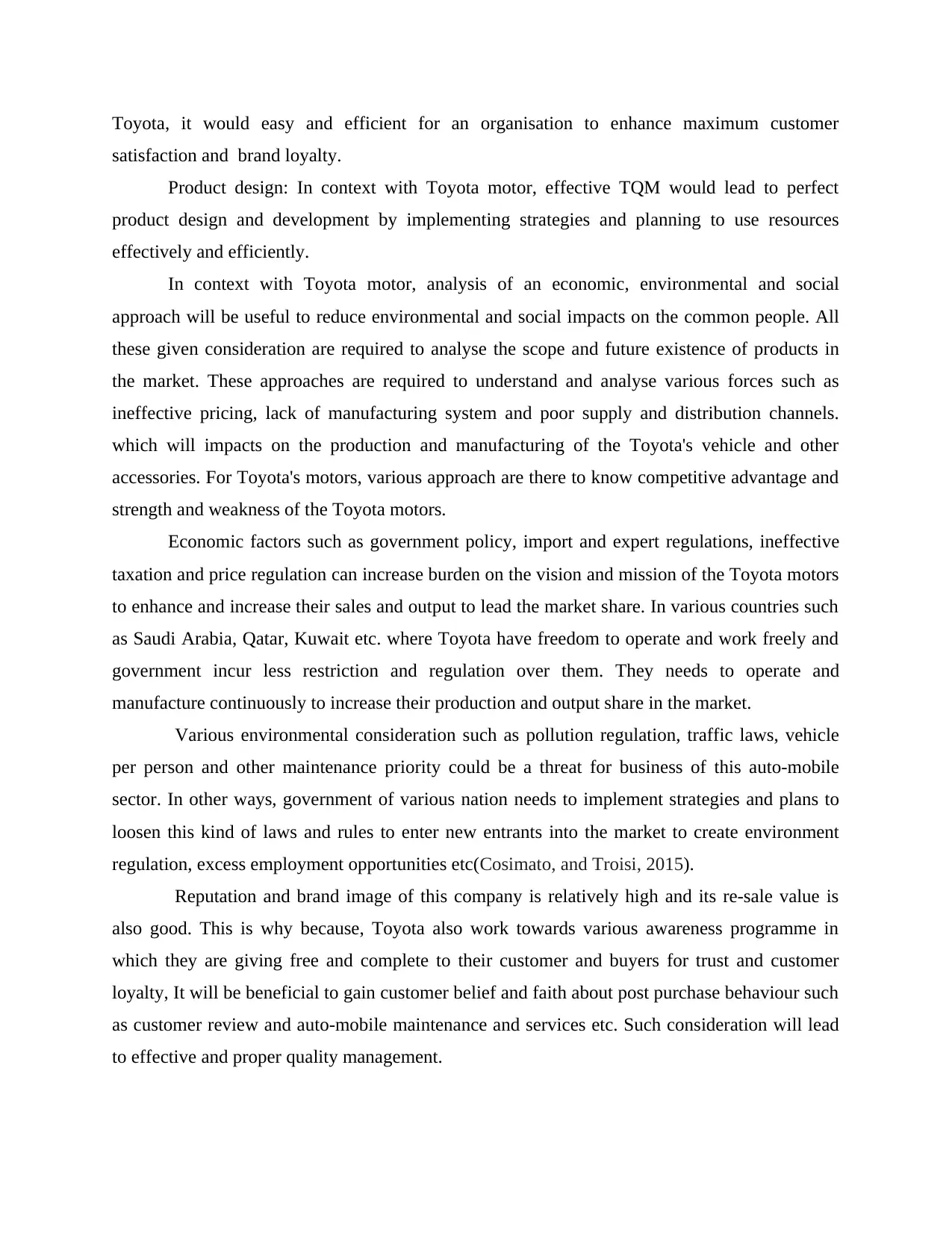
Toyota, it would easy and efficient for an organisation to enhance maximum customer
satisfaction and brand loyalty.
Product design: In context with Toyota motor, effective TQM would lead to perfect
product design and development by implementing strategies and planning to use resources
effectively and efficiently.
In context with Toyota motor, analysis of an economic, environmental and social
approach will be useful to reduce environmental and social impacts on the common people. All
these given consideration are required to analyse the scope and future existence of products in
the market. These approaches are required to understand and analyse various forces such as
ineffective pricing, lack of manufacturing system and poor supply and distribution channels.
which will impacts on the production and manufacturing of the Toyota's vehicle and other
accessories. For Toyota's motors, various approach are there to know competitive advantage and
strength and weakness of the Toyota motors.
Economic factors such as government policy, import and expert regulations, ineffective
taxation and price regulation can increase burden on the vision and mission of the Toyota motors
to enhance and increase their sales and output to lead the market share. In various countries such
as Saudi Arabia, Qatar, Kuwait etc. where Toyota have freedom to operate and work freely and
government incur less restriction and regulation over them. They needs to operate and
manufacture continuously to increase their production and output share in the market.
Various environmental consideration such as pollution regulation, traffic laws, vehicle
per person and other maintenance priority could be a threat for business of this auto-mobile
sector. In other ways, government of various nation needs to implement strategies and plans to
loosen this kind of laws and rules to enter new entrants into the market to create environment
regulation, excess employment opportunities etc(Cosimato, and Troisi, 2015).
Reputation and brand image of this company is relatively high and its re-sale value is
also good. This is why because, Toyota also work towards various awareness programme in
which they are giving free and complete to their customer and buyers for trust and customer
loyalty, It will be beneficial to gain customer belief and faith about post purchase behaviour such
as customer review and auto-mobile maintenance and services etc. Such consideration will lead
to effective and proper quality management.
satisfaction and brand loyalty.
Product design: In context with Toyota motor, effective TQM would lead to perfect
product design and development by implementing strategies and planning to use resources
effectively and efficiently.
In context with Toyota motor, analysis of an economic, environmental and social
approach will be useful to reduce environmental and social impacts on the common people. All
these given consideration are required to analyse the scope and future existence of products in
the market. These approaches are required to understand and analyse various forces such as
ineffective pricing, lack of manufacturing system and poor supply and distribution channels.
which will impacts on the production and manufacturing of the Toyota's vehicle and other
accessories. For Toyota's motors, various approach are there to know competitive advantage and
strength and weakness of the Toyota motors.
Economic factors such as government policy, import and expert regulations, ineffective
taxation and price regulation can increase burden on the vision and mission of the Toyota motors
to enhance and increase their sales and output to lead the market share. In various countries such
as Saudi Arabia, Qatar, Kuwait etc. where Toyota have freedom to operate and work freely and
government incur less restriction and regulation over them. They needs to operate and
manufacture continuously to increase their production and output share in the market.
Various environmental consideration such as pollution regulation, traffic laws, vehicle
per person and other maintenance priority could be a threat for business of this auto-mobile
sector. In other ways, government of various nation needs to implement strategies and plans to
loosen this kind of laws and rules to enter new entrants into the market to create environment
regulation, excess employment opportunities etc(Cosimato, and Troisi, 2015).
Reputation and brand image of this company is relatively high and its re-sale value is
also good. This is why because, Toyota also work towards various awareness programme in
which they are giving free and complete to their customer and buyers for trust and customer
loyalty, It will be beneficial to gain customer belief and faith about post purchase behaviour such
as customer review and auto-mobile maintenance and services etc. Such consideration will lead
to effective and proper quality management.
Paraphrase This Document
Need a fresh take? Get an instant paraphrase of this document with our AI Paraphraser

RECOMMENDATION
It is recommended that auto-mobile company should focus on maximum quality delivery
and customer satisfaction. Periodic service delivery approach will be suitable for Toyota and
other big auto-mobile to gain customer belief and trust to enhance market share and statutory
growth in the market. Company should take various approach such as economic, environment
and social as their main and focal opportunity and strategy to rise the market and diversity in the
market scenario. Business entities who are dealing auto-mobile industry needs to make effective
communication with the suppliers, logistic and dealer to purchase raw materials and input.
Organisations are required to follow legal rules and regulation of different economy to enhance
trading and business relations. Auto-mobile industry must set rules and framework to function
accordingly with the set scenario and trends of technology advancement and equipment up-
gradation etc.
It is recommended that auto-mobile company should focus on maximum quality delivery
and customer satisfaction. Periodic service delivery approach will be suitable for Toyota and
other big auto-mobile to gain customer belief and trust to enhance market share and statutory
growth in the market. Company should take various approach such as economic, environment
and social as their main and focal opportunity and strategy to rise the market and diversity in the
market scenario. Business entities who are dealing auto-mobile industry needs to make effective
communication with the suppliers, logistic and dealer to purchase raw materials and input.
Organisations are required to follow legal rules and regulation of different economy to enhance
trading and business relations. Auto-mobile industry must set rules and framework to function
accordingly with the set scenario and trends of technology advancement and equipment up-
gradation etc.

CONCLUSION
From the above assessment, it is concluded that operation management, logistics and
supply chain management is an important aspects of every auto-mobile industry. Effective
distribution and supply of the final products is possible by the help of skilled manpower and
usage of advance technology. Process of product development and designing is important to
manufacture new and effective product for the customer. Analysis of house of quality has
become essential for Auto-mobile organisation for developing new and innovative products.
TQM has proven essential for making customer experience effective and fruitful. Lastly, it is
concluded that analysis of economic, environmental and social approach is the pre-requisites for
enhancing productivity and profitability.
From the above assessment, it is concluded that operation management, logistics and
supply chain management is an important aspects of every auto-mobile industry. Effective
distribution and supply of the final products is possible by the help of skilled manpower and
usage of advance technology. Process of product development and designing is important to
manufacture new and effective product for the customer. Analysis of house of quality has
become essential for Auto-mobile organisation for developing new and innovative products.
TQM has proven essential for making customer experience effective and fruitful. Lastly, it is
concluded that analysis of economic, environmental and social approach is the pre-requisites for
enhancing productivity and profitability.
⊘ This is a preview!⊘
Do you want full access?
Subscribe today to unlock all pages.

Trusted by 1+ million students worldwide
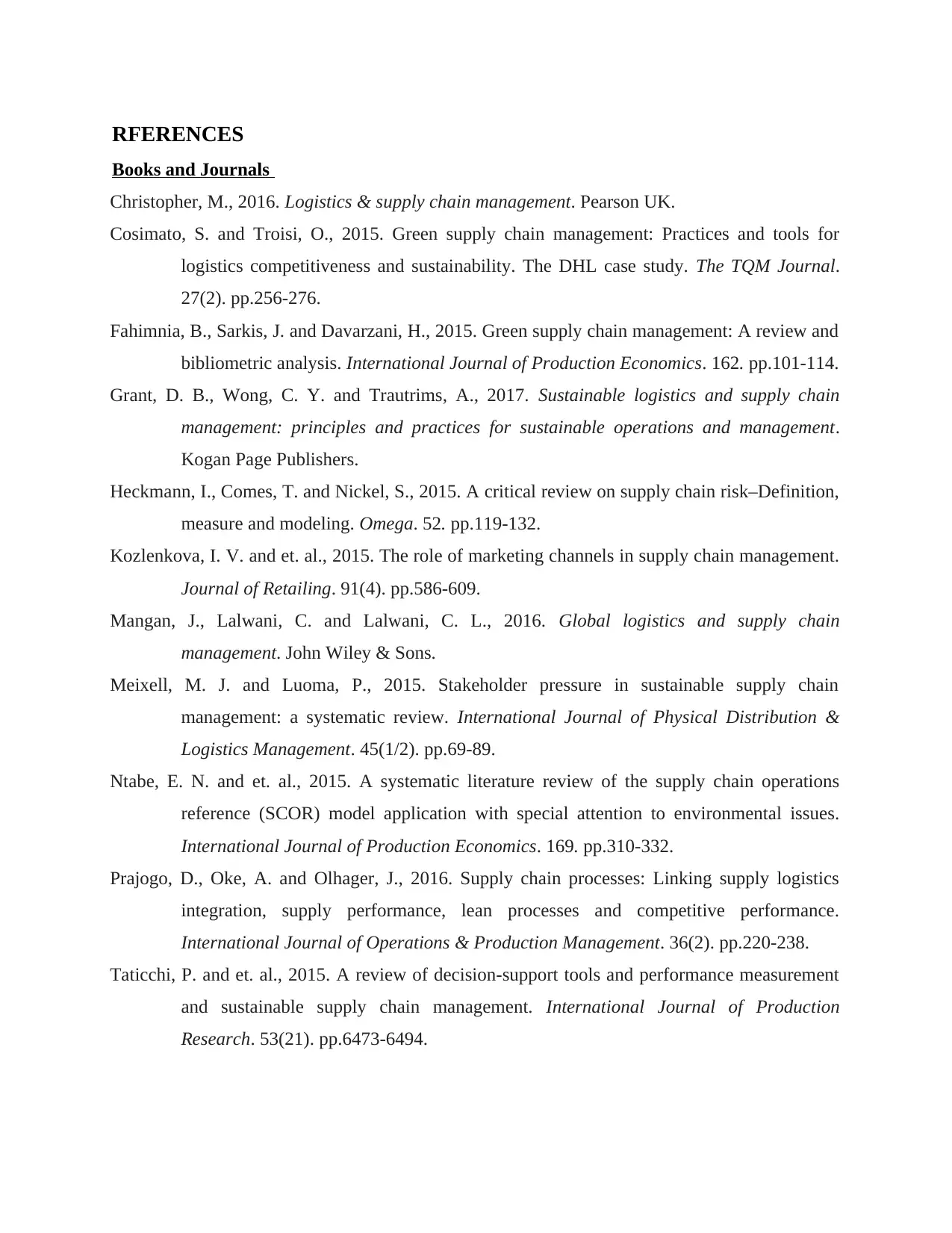
RFERENCES
Books and Journals
Christopher, M., 2016. Logistics & supply chain management. Pearson UK.
Cosimato, S. and Troisi, O., 2015. Green supply chain management: Practices and tools for
logistics competitiveness and sustainability. The DHL case study. The TQM Journal.
27(2). pp.256-276.
Fahimnia, B., Sarkis, J. and Davarzani, H., 2015. Green supply chain management: A review and
bibliometric analysis. International Journal of Production Economics. 162. pp.101-114.
Grant, D. B., Wong, C. Y. and Trautrims, A., 2017. Sustainable logistics and supply chain
management: principles and practices for sustainable operations and management.
Kogan Page Publishers.
Heckmann, I., Comes, T. and Nickel, S., 2015. A critical review on supply chain risk–Definition,
measure and modeling. Omega. 52. pp.119-132.
Kozlenkova, I. V. and et. al., 2015. The role of marketing channels in supply chain management.
Journal of Retailing. 91(4). pp.586-609.
Mangan, J., Lalwani, C. and Lalwani, C. L., 2016. Global logistics and supply chain
management. John Wiley & Sons.
Meixell, M. J. and Luoma, P., 2015. Stakeholder pressure in sustainable supply chain
management: a systematic review. International Journal of Physical Distribution &
Logistics Management. 45(1/2). pp.69-89.
Ntabe, E. N. and et. al., 2015. A systematic literature review of the supply chain operations
reference (SCOR) model application with special attention to environmental issues.
International Journal of Production Economics. 169. pp.310-332.
Prajogo, D., Oke, A. and Olhager, J., 2016. Supply chain processes: Linking supply logistics
integration, supply performance, lean processes and competitive performance.
International Journal of Operations & Production Management. 36(2). pp.220-238.
Taticchi, P. and et. al., 2015. A review of decision-support tools and performance measurement
and sustainable supply chain management. International Journal of Production
Research. 53(21). pp.6473-6494.
Books and Journals
Christopher, M., 2016. Logistics & supply chain management. Pearson UK.
Cosimato, S. and Troisi, O., 2015. Green supply chain management: Practices and tools for
logistics competitiveness and sustainability. The DHL case study. The TQM Journal.
27(2). pp.256-276.
Fahimnia, B., Sarkis, J. and Davarzani, H., 2015. Green supply chain management: A review and
bibliometric analysis. International Journal of Production Economics. 162. pp.101-114.
Grant, D. B., Wong, C. Y. and Trautrims, A., 2017. Sustainable logistics and supply chain
management: principles and practices for sustainable operations and management.
Kogan Page Publishers.
Heckmann, I., Comes, T. and Nickel, S., 2015. A critical review on supply chain risk–Definition,
measure and modeling. Omega. 52. pp.119-132.
Kozlenkova, I. V. and et. al., 2015. The role of marketing channels in supply chain management.
Journal of Retailing. 91(4). pp.586-609.
Mangan, J., Lalwani, C. and Lalwani, C. L., 2016. Global logistics and supply chain
management. John Wiley & Sons.
Meixell, M. J. and Luoma, P., 2015. Stakeholder pressure in sustainable supply chain
management: a systematic review. International Journal of Physical Distribution &
Logistics Management. 45(1/2). pp.69-89.
Ntabe, E. N. and et. al., 2015. A systematic literature review of the supply chain operations
reference (SCOR) model application with special attention to environmental issues.
International Journal of Production Economics. 169. pp.310-332.
Prajogo, D., Oke, A. and Olhager, J., 2016. Supply chain processes: Linking supply logistics
integration, supply performance, lean processes and competitive performance.
International Journal of Operations & Production Management. 36(2). pp.220-238.
Taticchi, P. and et. al., 2015. A review of decision-support tools and performance measurement
and sustainable supply chain management. International Journal of Production
Research. 53(21). pp.6473-6494.
Paraphrase This Document
Need a fresh take? Get an instant paraphrase of this document with our AI Paraphraser

Touboulic, A. and Walker, H., 2015. Theories in sustainable supply chain management: a
structured literature review. International Journal of Physical Distribution & Logistics
Management. 45(1/2). pp.16-42.
Wang, Y., Wallace, S. W., Shen, B. and Choi, T. M., 2015. Service supply chain management: A
review of operational models. European Journal of Operational Research. 247(3).
pp.685-698.
Online
Supply chain management, 2018. [Online]. Available through:
<https://searcherp.techtarget.com/definition/supply-chain-management-SCM>
structured literature review. International Journal of Physical Distribution & Logistics
Management. 45(1/2). pp.16-42.
Wang, Y., Wallace, S. W., Shen, B. and Choi, T. M., 2015. Service supply chain management: A
review of operational models. European Journal of Operational Research. 247(3).
pp.685-698.
Online
Supply chain management, 2018. [Online]. Available through:
<https://searcherp.techtarget.com/definition/supply-chain-management-SCM>
1 out of 11
Related Documents
Your All-in-One AI-Powered Toolkit for Academic Success.
+13062052269
info@desklib.com
Available 24*7 on WhatsApp / Email
![[object Object]](/_next/static/media/star-bottom.7253800d.svg)
Unlock your academic potential
Copyright © 2020–2025 A2Z Services. All Rights Reserved. Developed and managed by ZUCOL.





